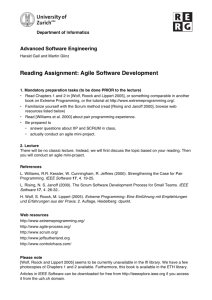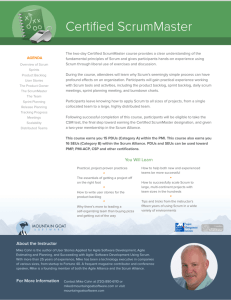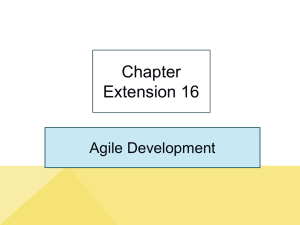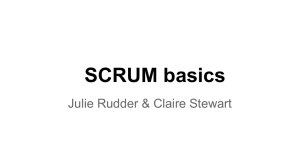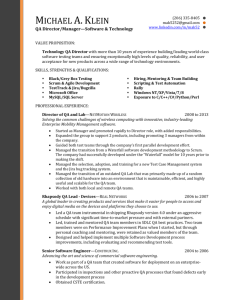Prodapt Consulting - Whitepaper - Agile
advertisement
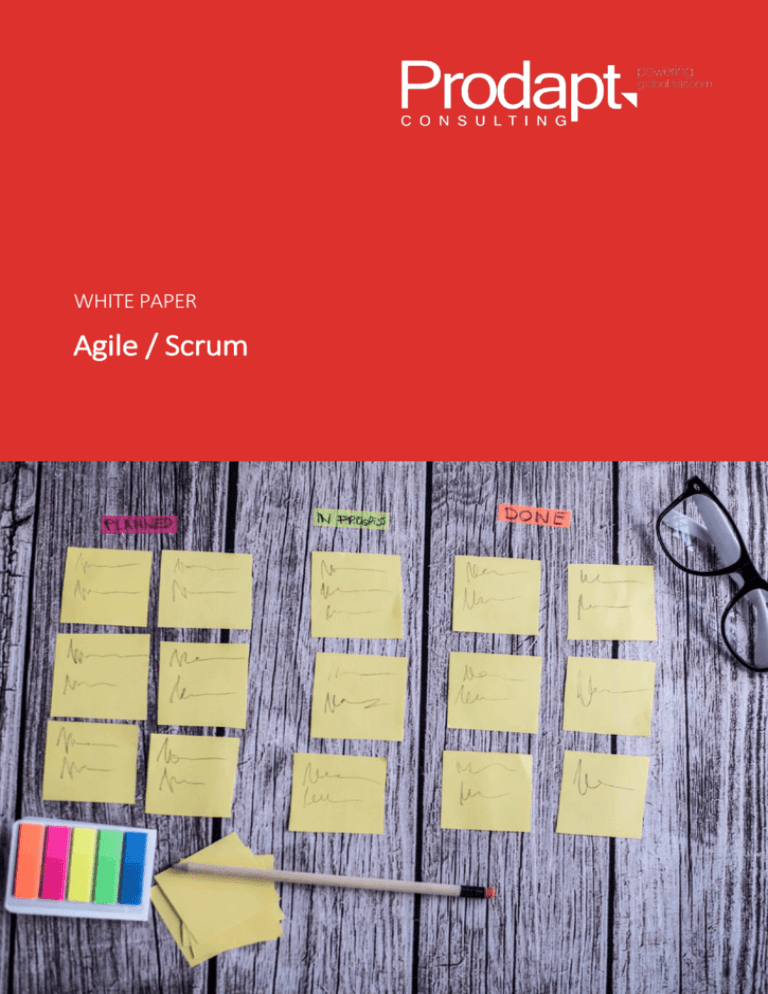
WHITE PAPER Agile / Scrum WHITE PAPER: AGILE/SCRUM Introduction Main character of Scrum is the development via a series of -shortiterations. In Scrum terminology we call these ‘sprints’. In short Scrum is an Agile process that, in general, is used for product development and, more specifically, for software development. Scrum is rather more a broad framework that can be applicable for every project with agressive deadlines and complex requirements. Main character of Scrum is the development via a series of -short- iterations. In Scrum terminology we call these ‘sprints’. Every sprint lasts usually between 2 and 4 weeks. Early 2001 a number of Agile experts came together, who detailed a number of values for Agile Software Development, this resulted in the symbolic “Agile Manifesto” (zie figure Figure 1 below). It is a best practice to follow these values, where possible of course. Via Scrum it becomes feasible to realise the highest possible value in the shortest timeframe. priorities, which are written down in a ‘product backlog’. In contrary to waterfall method already after a short time the first delivery will be ready to be released to production. An important character of Scrum is that the self-organising Scrum team will have its own control and responsibility and, of course needs to be closely aligned to the business priorities via the product backlog. There are little required rules, though some guidelines which should, historically driven, better be followed to make Scrum a success. In the next section these will be summarized. A Scrum team does not consist of the “standard set of people”, like designers, developers, testers, but is created on the basis that the expertise needed will be present to let the team achieve its goal. In general you will see a mix of above roles, but you will also see that people will take over each others roles. Very important is a good Figure 1: Agile Manifesto (source: www.agilemanifesto.org) Figure 2: Agile Manifesto (source: www.agilemanifesto.org) A standard principle is that, at the end of every sprint, the delivery can be released for usage (or it can be decided to continue, even with additional functionality, in a next sprint). The business is who sets the www.prodaptconsulting.com | 2 cooperation, always with the mindset: “we’re all in this together”. You will see for yourself how well this works and how driven teams are to come to the agreed result, when you start working like that. WHITE PAPER: AGILE/SCRUM Current Situation Agile Scrum and Overview With Scrum the ITBusiness relation improves and involvement of Business with IT increases. Within software development Agile often was a “not done” word. This was predominantly because of a lack of awareness and from the thought that the waterfall method simply was working, so why change ? From the mid 90’s and more even this century Agile (and Scrum) started to prove its worth and many organisations realised it was working much better than how they were used to work before. Especially the high speed of software deliveries is being seen as a major advantage compared to waterfall and with that a better Return on Investment. Finally also the overall happiness of employees has been important in the acceptance of Agile/Scrum. Companies often mention that their employees are their most valuable asset. With Agile/Scrum people seem more content and the overall work spirit grows, which often contributes to the overall company results. Also from demand/business side you often hear that with Scrum the IT-Business relation improves and involvement of Business with IT increases. You’ll find this also in the Netherlands and multiple, also large, organisations have decided to embrace an Agile way of working. For a more detailed explanation on Scrum what now follows is a number of standard expressions, through which the method of working will become clear almost automatically: Scrum only knows 3 different roles: 1) Product owner (sometimes delegated by a Story owner): Determines the functionality of the product Determines content, priority, enddate Is responsible for the profitability (ROI) Functionality and priority can be changed every iteration, as needed Accepts the end result (or will not accept) 2) Team Usually 5-9 people (7 ± 2) Multi-disciplinary: developers, testers, designers, etc. Team members should be assigned full time with some exceptions (like: database administrator, UNIX specialist) Teams organise themselves Members only change teams between sprints, never during sprints ! 3) Scrum master Representation of the management to the project Responsible for application of the Scrum values and standards Supports resolving of impediments Takes care of the optimal productivity of the team Supports collaboration between several disciplines and roles Protects the team from disturbances from outside the team. Every sprint will typically have the following components, which have an advised duration, which is related to the duration of the sprint: Sprint planning. At the of the sprint the team selects those parts of the product backlog, for which they will commit themselves. These items form the sprint backlog. Daily standup scrum meeting. This session is by definition standup, this to prevent it will otherwise simply take too long, 15 minutes maximum would be the advised duration. With this session several unnecessary other meetings should be prevented. www.prodaptconsulting.com | 3 WHITE PAPER: AGILE/SCRUM During this session every team member answers the following questions: 1) What did I do yesterday ? 2) What will I do today/ until tomorrow? 3) Do I see/have impediments ? Everybody interested is welcome to attend, but: only the Scrum master, team members and product owner are allowed to speak. adjusted after (not during !) every Sprint. In the end this set of requirements forms the basis for a succesful Scrum implementation and it’s therefore key that the necessary attention will be given to create this. A format often used to describe the components of this backlog is the user story. In a user story, every item is defined as (example): Figure 3: Scrum in a single picture (source: Mountain Goat Software) Sprint review. The team presents what it has achieved during the sprint. Most of the time this will be a demo of new features or the product. Sprint retrospective. At the end of the sprint all look into possible improvements for a next sprint. This is for the whole team, product owner and Scrum master, customers are allowed to join. Questions like “what will we do differently” or “what should we continue to do” will be answered. This In a user story, every item is defined as (example): “As a back-office member I need to have an up to date overview of outstanding work, with a maximum of 3 mouse-clicks”. The previously mentioned product backlog is the listing of all demands / wishes which the product owner needs implemented. Priority will be set by the product owner and can be www.prodaptconsulting.com | 4 “As a back-office member I need to have an up to date overview of outstanding work, with a maximum of 3 mouse-clicks”. Prodapt Consulting experience with Agile/ Scrum While working for a utility company in the Netherlands, multiple Prodapt Consulting employees have supported the process to start working with Scrum. Roles like Scrum master and Story owner were performed. In this way completely new software was developed and delivered, all to complete satisfaction of the customer. WHITE PAPER: AGILE/SCRUM At an international Telecoms Provider, from the start of the transition to Scrum, many Prodapt Consulting employees cooperated, this in several different roles. Both at Business-side (Product and Story owners) as well in the IT-area, in Scrum teams and as Scrum masters. At this provider the amount of Scrum teams has grown a lot since the start and the success in deliveries of, quite often very complex solutions, has grown, much to the satisfaction of all involved. In 9 sprints a fully working (Fulfillment, Assurance and Billing) system was created. One example: in 9 sprints a fully working (Fulfillment, Assurance and Billing) system was created. Despite the high complexity and several coordination challenges (there were interfaces between 11 systems and 6 different teams were involved, of which one was still working in waterfall mode) the product became to requested maturity and ready for sale within agreed timeframes. At this provider Prodapt Consulting also contributed in setting up the process with regards to the offshore testing team. These offshore testers are now incorporated in the Scrum teams as full-fledged team member. Known issues, like attending the standup sessions have been resolved through video conferencing. Next to that the Scrum boards have been digitalised, so everyone can work with them, irrespective of their location. Prodapt Consulting Scrum masters, Product and Story owners: experienced, competent, flexible Prodapt Consulting has multiple certified Scrum employees, both Scrum masters as well as Product owners. They have been involved during implementations of Scrum / transitions towards Scrum and are experienced in the execution with Scrum during many Sprints, as you can read in section 3. Sources Sources: Mountaingoatsoftware / Mike Cohn; Agile software management applied, Ken Schwaber. www.agilemanifesto.org Within another large Telecoms provider Prodapt Consulting employees contributed as Story owner and Scrum master during many sprints. www.prodaptconsulting.com | 5 Contact Details Europe Prodapt Consulting B.V. De Bruyn Kopsstraat 14 2288 ED Rijswijk Z-H The Netherlands Phone : +31 70 414 0722 Adriaan van Donk Phone : +31 6 5335 4335 E-mail : adriaan.van.donk@prodaptconsulting.com Ben van Leliveld Phone : +31 6 5335 4337 E-mail : ben.van.leliveld@prodaptconsulting.com Paul Termijn Phone : E-mail : +31 6 3010 9117 paul.termijn@prodaptconsulting.com www.prodaptconsulting.com


